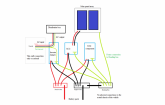EllaBella
New Member
- Joined
- Mar 7, 2020
- Messages
- 23
Unfortunately to charge 48v you would need to input a higher voltage, so you would need to step up from the 12v to 48v. For example if I want to charge my 48v battery bank, I'd have to have 60v+ to charge it effectively and so I'd put my solar panels in series until I've achieved the desired voltage needed.If taking the idea of an 'additional' 12v battery pack further, whereby it had two power sources, 1/ victron orion TR 48/12-30A from 48v bank & 2/ victron orion TR smart 12/12-30 from the alternator/engine battery.
My question is, would you connect the output from 1/ TR 48/12-30 to the aux 12v battery bank along with the TR 12/12-30 or would you direct the output through the DC blade fuse distribution block?
I presume keeping the more critical/always on loads on the 12v side and luxuries on the 48v/inverter side.
Would i need any battery protects or is that all handled by the victron units themselves?
View attachment 8805
Yes, that would do it perfectly, especially as it supports smart alternators. Thank you for the link.Hi,
I'm facing the same issue and wonder: would this do the job? https://www.sterling-power-usa.com/SterlingPower12volt-to-48volt-batterytobatterycharger.aspx
I'd like to see the efficiency data though but I couldn't find it in the documentation on their website.




